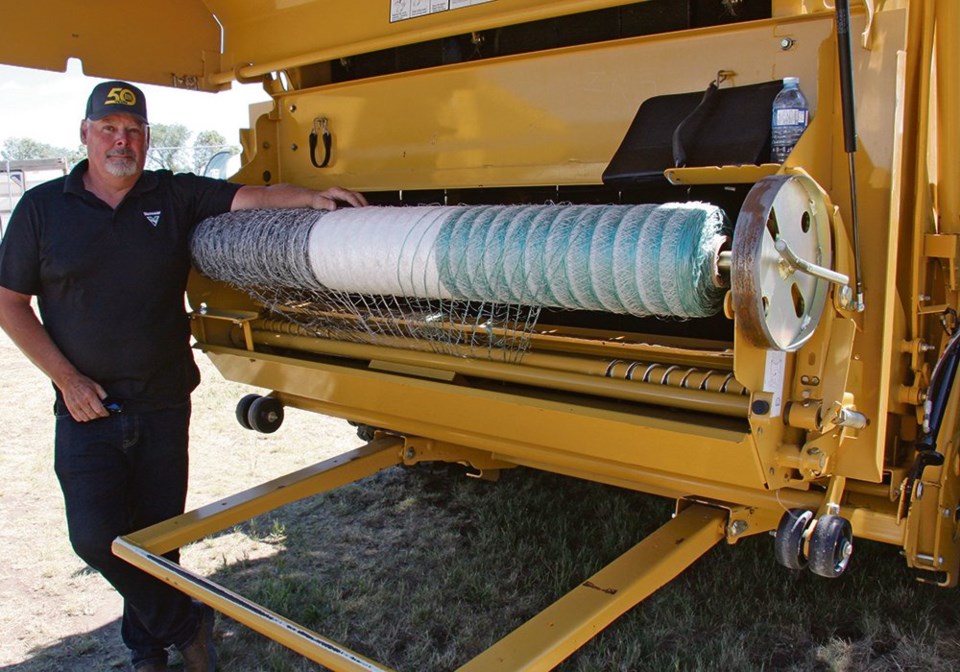SASKATOON — Long ago, tractor was king. It pulled and powered swathers, combines, balers and sprayers. When self-propelled arrived, the baler became the final pull-type holdout. Well, the baler has finally caught up.
Vermeer launched its ZR5-1200 self-propelled big round baler two years ago. With so many farm shows cancelled because of COVID, the new baler received little attention.
In 2022, outdoor farm shows such as Ag In Motion near Saskatoon returned and many innovations that had been parked in the shed for two years were moved out into the prairie sunshine.
Vermeer representative Corey Dalman made good use of the AIM opportunity to haul the ZR5 to Langham for the show. He says the machine’s development came quickly because the company already had the basic baler component to build on. The ZR5-1200 is basically an enhanced version of the pull-type machine that’s been around for a while. Vermeer’s large industrial division was able to provide the power plant, controls and cab expertise.
“Our lead engineer on the ZR5 had previously worked on the industrial side of the company, so everything moved along at a good clip,” said Dalman, adding that on paper the ZR5 should have the same performance as the PT.
“But it doesn’t. In my experience with the ZR5 so far, I believe it has a performance benefit over the pull-type. The pickup on the pull type is never fixed solid to the baler. It’s always moving in relation to the tractor and to the baler, so you always have the pickup and baler moving on their own. The stroke at the baler off the pickup is always changing. With the self-propelled baler, the relationship between pickup, baler and power unit always stays the same.
“Because of the new hydraulics, when we go into the wrap mode, we have a 30 percent increase in tie speed compared to the pull-type.”
He said the self-propelled is fully automated. Operators use a joystick in the cab to set ground speed.
“After that, you just steer. It stops on its own. It wraps on its own. Ejects the bale. Closes the rear door. When that’s done, you just hit the resume button on the joystick, just like the resume on cruise control, and it gets right back to work.”
Dalman says that with the large glassed-in cab upfront, the operator is looking down directly at the swath. Unlike a pull-type, there’s no turning around to see what’s going on behind the tractor.
The cab is suspended and has an air ride seat. There’s one camera at the front focused on the pickup and another camera at the back aimed at the bale coming out of the bale chamber.
In transport mode, this camera rotates to give the driver a clear view of about 1.5 kilometres of road behind. Its road speed is 54 km-h. The suspension allows the baler to travel across hay land at 19 km-h. The ZR5 is powered by a Cummins146-kW diesel.
Dalman says Vermeer carried out an in-field comparison between the pull-type and the new self-propelled model. Every effort was made to equalize the two machines, including installation of a CVT hydrostatic transmission into the tractor to ensure the test was not comparing drive systems. Engines were the same, rated at 200 horsepower. Tests were conducted on the same day, same field, on adjacent windrows.
“All things being equal, the self-propelled ZR5 was 1.6 to 1.9 times faster than its older pull-type cousin. At that speed, it was putting up more bales per hour.
“Think about the tractor investment and cost of operation. Most of the tractors you would use to pull your (pull-type) baler have big six-cylinder diesel engines. They’re bigger and more powerful than required. The ZR5 has a fuel efficient four-cylinder that’s matched to the needs of the baler. That’s less cost and less fuel burned. Cost per bale is substantially less with the ZR5. We figure cost per bale ranges from 25 percent less, up to 40 percent less.
“Most farmers have a dedicated baler tractor. The SP baler eliminates that tractor from your inventory. Price today on the ZR5 is $325,000 in Canada. If you were to go and buy a new 200 horse tractor plus a new pull-type baler, you’d spend a lot more than that.”
Dalman says the power unit should outlast three baler units. This allows the grower to trade balers without trading the power unit. The take-off baler can be kept on-hand as a spare. Hydraulics in the baler come from the Vermeer industrial division and are engineered to last 10,000 hours.
However, with the bale chamber removed, the farmer now has a dedicated power unit sitting idle. Isn’t this a wasted investment?
“Don’t worry. Vermeer has a couple things in mind coming down the line for the tractor unit.”

